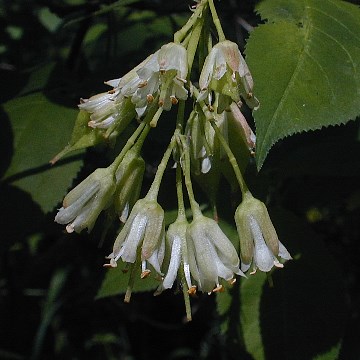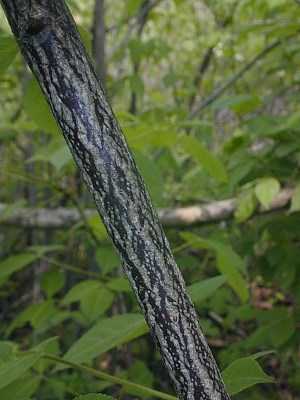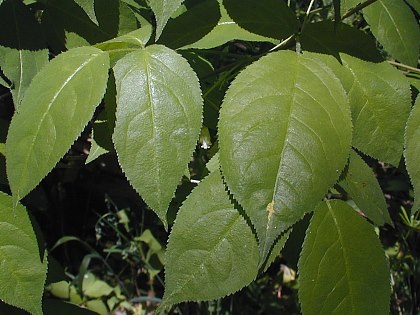Description: This shrub is about 6-12' tall, branching irregularly and somewhat sparingly (especially in shaded areas). The trunk and/or larger branches have bark that is mostly grey and slight rough-textured, while smaller branches have bark that is smooth with longitudinal streaks of black and light grey. Young twigs tend to be smooth and reddish brown.

The opposite
leaves are trifoliate; they have petioles about 1-5" long. Individual
leaflets are up to 2½" long and 1" across; they are ovate in shape and
finely serrated along their margins. Each leaflet has a rounded to
wedge-shaped bottom and tapers to a tip that is short and slender; the
upper surface of each leaflet is medium to dark green and hairless,
while the lower surface is light green and pubescent. The terminal
leaflet has a stalk (or petiolule) up to 1" long, while the 2 lateral
leaflets are nearly sessile. Drooping clusters of flowers develop from
the axils of the compound leaves. Each flower is about 1/3" (8 mm.)
long, 1/4"
(6 mm.) across, and bell-shaped; it has 5 outer sepals, 5 inner petals,
several stamens, and a pistil. Initially, both the sepals and petals
are white; shortly later the sepals become light green or dull pink.
The slender pedicels are a little longer than the flowers. The blooming
period occurs during mid- to late spring and lasts about 2-3 weeks.
Each fertile flower is replaced by a papery 3-celled seed capsule up to
3" long and 2" across; this
capsule is obovoid or ovoid in shape with 3-angular lobes. Immature
capsules are green during the summer, but they become light brown
during the fall. At this time, the seeds can be made to rattle inside
their capsule; there is a single seed per cell. The seeds are brown,
smooth, and about ¼" across. The root system can form clonal
offsets from underground runners. Occasionally, colonies of shrubs are
formed.
Cultivation:
The preference is light shade to partial sun, moist conditions, and a
fertile loamy soil with abundant organic matter. This shrub has few
problems with pests and disease.

Range &
Habitat:
The native Bladdernut occurs in every county of Illinois and it is
fairly common (see Distribution
Map). Habitats include moist floodplain woodlands, mesic
woodlands, riverbanks, and thickets. Bladdernut is typically found in
deciduous woodlands where such trees as Sycamore, Silver Maple, Sugar
Maple, American Basswood, and/or River Birch are present. Sometimes,
this shrub is cultivated because of its attractive flowers, seed
capsules, and leaves.
Faunal Associations:
The flowers attract honeybees, bumblebees, Halictid bees (Halictus
spp., Lasioglossum spp.), Andrenid bees (Andrena
spp.), Syrphid flies, dance flies (Empis spp.),
and the Giant Bee Fly (Bombylius major). Most of
these insects suck nectar from the flowers, although the Syrphid flies
feed on the pollen and some of the bees collect pollen for their
larvae. Another insect, Thrips quinciensis, has
been observed sucking juices from Bladdernut (see Stannard, 1968),
while Lopidea staphyleae (Bladdernut Plant Bug), is
a monophagous or oligophagous feeder on this shrub (see Knight, 1941).
Additional
information about floral-faunal relationships for this species is
scarce. Apparently, White-Tailed Deer are less likely to browse on
Bladdernut than other woody shrubs, although the reasons for this
preference are unclear.
Photographic Location:
A floodplain woodland in Vermilion County, Illinois.

Comments: Bladdernut is the only member of its family in Illinois. When the flowers or seed capsules are present, this shrub is easy to identify – look for its drooping clusters of bell-shaped flowers or large papery seed capsules. In particular, the seed capsules are highly unusual in appearance and somewhat ornamental, reminding me of the papery husks that cover the berries of Physalis spp. (Ground Cherries), but the former are much larger in size and more angular in shape. The opposite trifoliate leaves of Bladdernut are also distinctive – other shrubs have alternate leaves, simple leaves, or compound leaves with more leaflets. Sometimes Staphylea trifolia is called 'American Bladdernut' to distinguish it from other shrubs in the Bladdernut family.